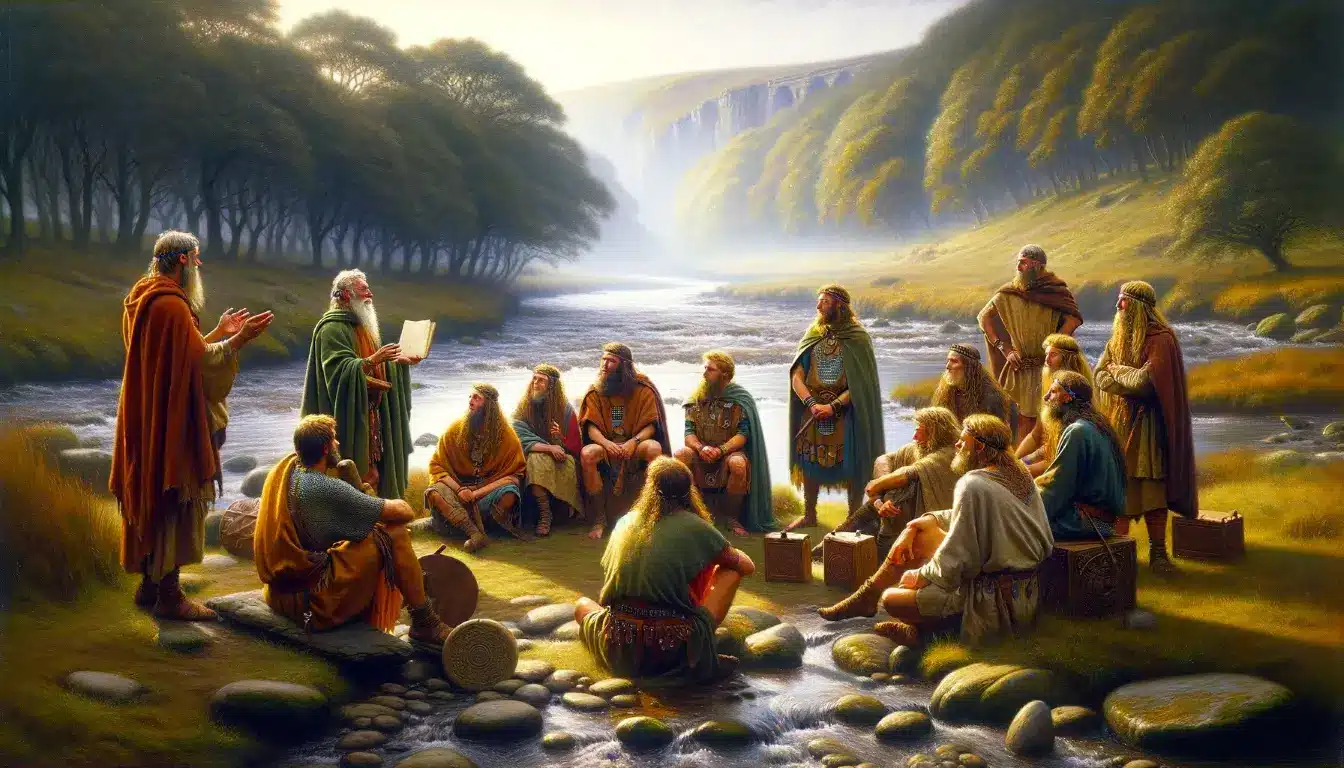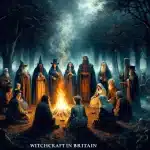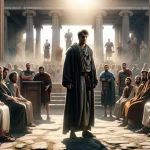Last Updated on 21/01/2024 by Alex Hamlyn
Table of Contents
Celtic beliefs about witchcraft, as with many aspects of ancient Celtic culture, are somewhat obscured by the lack of direct written records from the Celts themselves. In particular, we lack first hand written documents about witchcraft and Celtic Britain from that time period.
Much of what is known comes from archaeological evidence and accounts written by Roman and early Christian authors. We have to approach these sources with caution, as they often reflect the biases and cultural perspectives of their time. However, we can piece together a general understanding of Celtic beliefs and practices that may have included elements akin to what we would call “witchcraft.”
Druids and Spiritual Leaders
The Druids, occupying a revered and influential position in Celtic societies, formed the backbone of spiritual and intellectual leadership. As the priestly class, they undertook a variety of practices that we might classify today as both spiritual and magical. The Druids were more than just religious leaders; they were the custodians of legal knowledge, educators, and advisors to Celtic kings and chieftains.
Functioning as intermediaries between the gods and the people, Druids conducted religious rituals, presided over sacred ceremonies, and were believed to possess profound insights into the natural and supernatural worlds. Their responsibilities extended to the practice of divination, where they interpreted omens and signs to predict future events or unravel the will of the gods. This practice was integral to Celtic society, influencing decisions ranging from when to sow crops to when to wage war.
Healing was another crucial aspect of Druidic practice. They were likely well-versed in the medicinal properties of plants and herbs and may have employed various healing rituals and ceremonies believed to harness spiritual energies for physical and mental well-being. Their knowledge of plants and herbs likely extended into realms that today would be considered the practice of herbalism and natural medicine.
This wealth of knowledge, combined with their spiritual duties, rendered the Druids an indispensable pillar of Celtic society.
Nature and Animism
Celtic spirituality in ancient Britain was profoundly intertwined with the natural world, reflecting a deep reverence for the land and its various elements. The Celts viewed the natural world not just as a resource or backdrop to their lives but as an integral part of their spiritual existence. They held sacred numerous natural sites – rivers were seen as sources of life and renewal, groves were often considered dwellings of deities, and hills and mountains were revered as places where one could be closer to the celestial realm. Such sites were frequently the settings for religious rituals and ceremonies, believed to be places of heightened spiritual power where the veil between the mortal world and the divine was thin.
This connection to nature was underscored by an animistic belief system, a worldview in which all aspects of the natural world were thought to possess a spiritual essence or consciousness. Trees, rocks, rivers, and animals were not seen as inanimate or soulless entities; rather, they were imbued with spirits or were manifestations of divine beings. This belief led to practices and rituals designed to honour, appease, or communicate with these spirits.
The changing of the seasons, cycles of the moon, and agricultural cycles were all deeply significant to the Celts, who saw these natural phenomena as reflections of the actions or moods of various deities. Their rituals and festivals, therefore, were closely tied to these natural cycles, celebrating the rhythms of the earth and acknowledging the interdependence of human life with the natural world.
Otherworld – Where witchcraft and Celtic Britain first meet
The concept of the “Otherworld” was a central tenet in Celtic spirituality, representing a realm beyond the physical, where deities, spirits, and ancestors resided. This Otherworld was not seen as a distant, separate place but rather as existing alongside the mortal world, interwoven and accessible under certain conditions. It was believed to be a place of great beauty and abundance, a source of wisdom and esoteric knowledge, and the destination of souls after death. The Celts viewed the Otherworld as a parallel existence, where time flowed differently, and the beings who dwelled there possessed powers and knowledge beyond human understanding. Access to this realm was thought possible during specific moments or in particular places, such as sacred groves, caves, or hills, where the veil between worlds was thin.
Samhain, one of the most significant festivals in the Celtic calendar, exemplified the permeability between the earthly world and the Otherworld. Celebrated at the end of the harvest season, Samhain marked a time when the barriers between worlds were believed to be at their weakest, allowing for communication and interaction with the inhabitants of the Otherworld. It was a time for honouring ancestors, appeasing spirits, and seeking the guidance of the deities. The festival involved various rituals and practices, such as bonfires, feasts, and offerings, aimed at protecting against harmful spirits and ensuring a smooth transition into the darker half of the year.
This is perhaps where we find our first real connection between witchcraft and Celtic Britain. Samhain’s legacy endures in modern Halloween traditions, which retain echoes of these ancient beliefs in the supernatural and the thinning of the veil between worlds. This festival, along with others in the Celtic tradition, highlights the deeply ingrained belief in the interconnectedness of the physical and spiritual realms and the ongoing influence of the ancestors and spirits on the living world.
Magic and Curses
Evidence from Celtic regions, particularly from the Roman and post-Roman periods, suggests a belief in the power of curses and protective charms. Items like curse tablets and amulets found in archaeological sites indicate practices that could be considered magical. Beliefs like this are not unique to the Celts, however, as these practices have been found worldwide, and across cultures.
The notion of magic in the context of Druids is complex. While they might not have practiced ‘magic’ in the way it is often depicted in popular culture, their skills, knowledge, and rituals could have been perceived as magical by those outside their tradition. Their connection with nature, ability to interpret signs and omens, and role in conducting rituals and ceremonies could have been seen as wielding a form of mystical power.
Warrior Culture and Prophecy
In some Celtic societies, there were traditions of warrior cults and prophetic divination. The figure of the seer or prophetess, who might foretell the outcomes of battles or the fates of heroes, was a recurring theme in Celtic myths and sagas.
Over time, as the Celts were Christianized, many of their spiritual practices were absorbed, modified, or demonized by Christian traditions. For example, some Celtic deities were transformed into Christian saints. A notable example is St. Brigid of Kildare in Ireland, who shares many attributes with the Celtic goddess Brigid. Likewise, ancient Celtic sacred sites, such as wells, springs, and groves, were Christianized and became associated with saints. Pilgrimages to these sites continued under the auspices of Christian practice. The Isle of Iona in Scotland, for example, was a significant Druidic site before becoming an important Christian centre.
While the term “witchcraft” in its modern sense might not directly apply to ancient Celtic beliefs, the Celts had a spiritual tradition that included practices which could be likened to magic, divination, and herbalism. Their spiritual worldview was deeply connected to nature, the Otherworld, and the community’s well-being. Celtic spiritual practices and beliefs, especially as mediated through the Druids, were an integral part of their culture and society.
Beliefs about witchcraft and Celtic Britain are hard to match with modern ideas, or the traditional views we understand from periods like persecutions of the 1600s, but we can find evidence of ancient spiritual beliefs and begin to trace the evolution of witchcraft and magic in the British Isles.
Read more in this series
Witchcraft in Britain
An Introduction
Witches in Roman Britain
(1st-5th century)
Viking Britain and Witchcraft
(8th-11th century)
Medieval Britain and Witchcraft
(5th century onward)
Plantagenet and High Medieval Britain (12th-15th century)
17th Century: The Peak of Witch Hunts in Britain
Modern Britain And Witchcraft – As Strange As Ever
Witchcraft and the Celts
(Pre – AD43)
Witches in Saxon Britain
(5th-11th century)
Norman Britain and Witchcraft
(11th-12th century)
Early Modern Period and Restoration (15th-18th century)
Victorian Britain and Witchcraft
(19th-20th century)
Famous Witches in British History
(Plus one Witch Hunter)


